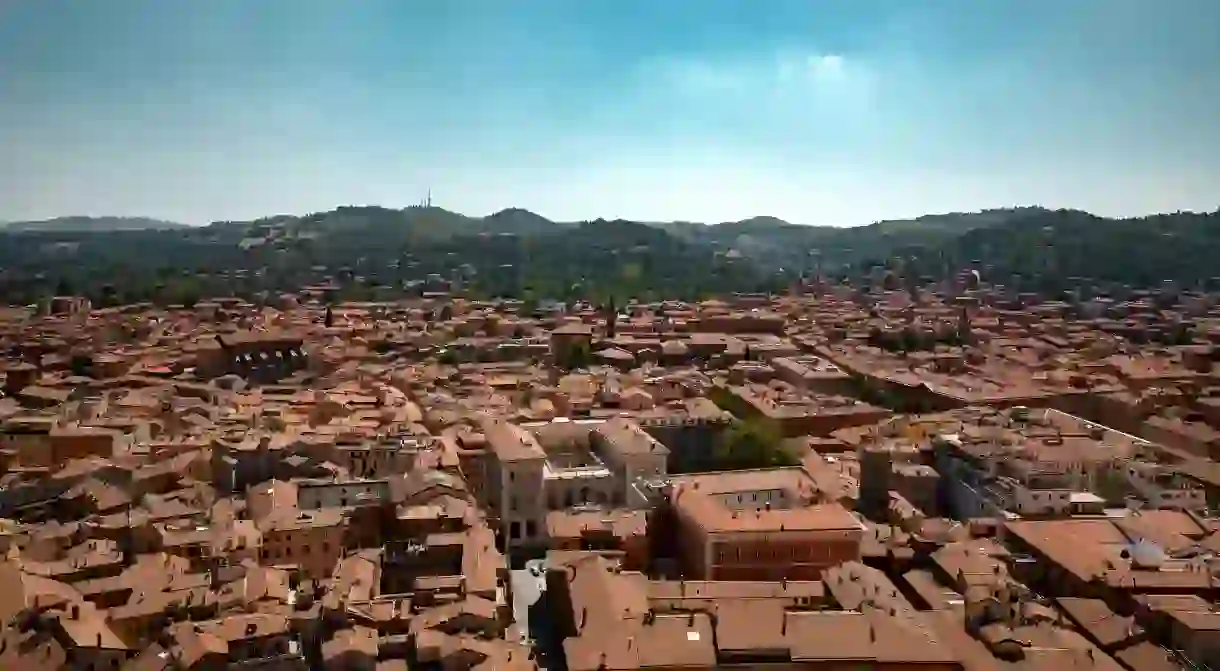16 Must-Visit Attractions in Bologna

The birthplace of bolognese sauce is perfect for a food-lover’s pilgrimage, but Bologna has more going for it than meaty pasta. Explore this northern Italian city’s vaulted arcades, museums and basilicas, plus its fantastic eateries.
Well-known the world over for its fabulous food and eponymous pasta sauce, Bologna – the capital of the Emilia-Romagna region – is the perfect destination for experiencing and tasting the real Italy. The red-brick-and-terracotta medieval centre is characterised by porticoes and medieval towers, and is easily explored on foot. Bologna’s university, dating from 1088 and one of the oldest in the world, continues to thrive and contributes to the city’s successful combination of tradition and innovation. Here are the top must-visit attractions in Bologna, Italy.
Spaghetti (or tagliatelle) bolognese
Restaurant, Italian

Widely considered as Italy’s foodie capital, Bologna takes its specialities seriously and over 30 traditional recipes are registered at the Chamber of Commerce, which also keeps a strip of gold the exact dimensions of perfect tagliatelle – 8mm, for your information. Meat-filled tortellini and tagliatelle al ragù – the authentic version of spaghetti bolognese – reign when it comes to pasta. Find out what real bolognese sauce tastes like at informal lunch spot Sfoglia Rina or in the evening at traditional Trattoria Serghei, then try to recreate it when you get home.
Covered arcades (portici)
Historical Landmark

With more covered pavements than anywhere else in the world – nearly 24mi (40km) – in Bologna, you’re always protected from the rain or hot sun. These porticoes first began to appear in the 11th century to house the city’s fast-growing university population above the arcades, without occupying extra terrain, and in 1288 a law was passed making them obligatory. While some original medieval wooden porticoes remain, including at Strada Maggiore 19, in Via Marsala and behind the Corona d’Oro Hotel, most are brick or stone, with columns, archways, vaulted ceilings and marble floors.
Quadrilatero old market
Market
Produce stalls and food shops have filled this knot of narrow lanes just off Piazza Maggiore with colour and aroma since medieval times. Nowadays, it’s one of Bologna’s most picturesque spots for a snack or meal at the numerous deli-eateries. Don’t miss the Osteria del Sole wine bar which dates from 1465 – only wine is served, but you can bring your own food. For more tasty market bites check out Mercato delle Erbe, the city’s largest covered food market, which is also in the centre.
Museo della Storia di Bologna
Museum

Asinelli Tower
Building

Piazza Maggiore
Building
Basilica di Santo Stefano
Church
San Luca Sanctuary
Church
FICO food centre
Market, Italian
Since its 2021 makeover, this massive foodie centre just outside the city – hop on bus 35 – has become a kind of theme park dedicated to the origins of food, with fun and educational experiences both for children and adults: think multimedia exhibits, live demonstrations, tastings and cookery classes. There are farm animals and crops, producers of traditional foods and plenty of opportunities for the two most important elements of a trip to Bologna, eating and drinking.
Former ghetto district
Wine Bar, Italian
With its compact tangle of cobbled alleys, Bologna’s historic former ghetto district, just round the corner from the Asinelli Tower, is one of the most atmospheric parts of town. Craft workshops sell beautiful handmade items including traditionally made artistic prints and custom shoes, and there’s a Jewish museum and heritage centre. Soak up the atmosphere over an aperitivo at wine bar Camera a Sud.
Little Venice
Architectural Landmark
Not many travelers are aware of it but underneath the city of Bologna are a whole load of canals. So if you think you’re hearing water drifting while you’re wandering around town, well, perhaps you are! And it turns out that from a little, picturesque window set in via Piella, it’s actually possible to see one of those canals trickling along through the Storico’s trademark red-brick homes. Recommended by Carlotta Bosi.
Giardini Margherita
Park
As in many other cities in Italy, Bologna offers its fair share of hidden parks and gardens to kick back in under the Italian sun. At the gate of the Centro Storico itself, Giardini Margherita is a huge public garden, where everyone is free to take a stroll, admire the fountains or just lay on the grass and enjoy the sun. This is also a beloved spot of the city’s many students, who can be spotted taking breaks between classes. Recommended by Carlotta Bosi.
Mambo
Museum
Despite its name, Mambo is not a dance club. It is in fact an acronym for the Modern Art Museum of Bologna (Museo d’Arte Moderna di Bologna). It features a wide and permanent collection alongside interesting temporary exhibitions and hosts works by the likes of Giorgio Morandi, the late Bolognese artist of considerable fame. Recommended by Carlotta Bosi.
Biblioteca Federico Zeri
Library
Established in 1999 by Università degli Studi di Bologna, this fascinating library, containing up to 80,000 art volumes of various kinds, is dedicated to the late Italian art critic Federico Zeri, from which it takes its name. The Federico Zeri Library is set in the former Santa Cecilia Convent, where the Art Department of the University also resides. The cloister is definitely worth a visit in its own right, even if you aren’t the bookworm sort! Recommended by Carlotta Bosi.
Casa Carducci
Museum
This house, as the name suggests, was the home of one of the greatest Italian poets of the 19th century, Giosuè Carducci. At Casa Carducci, all the original furnishings are still in place and it now serves as a library and a museum, administrated by Comune di Bologna. It hosts the poet’s archive which is open to the public for consultation, while school programs and public events are also available. Recommended by Carlotta Bosi.
Pinacoteca Nazionale
Art Gallery, Museum













